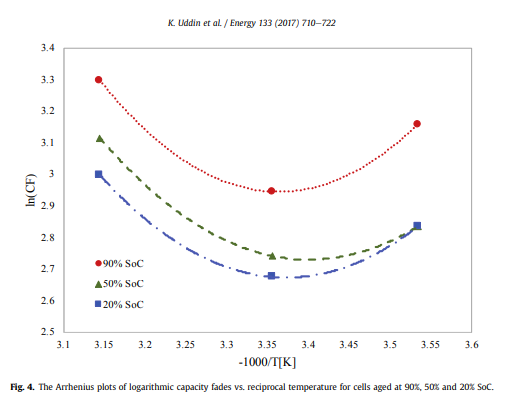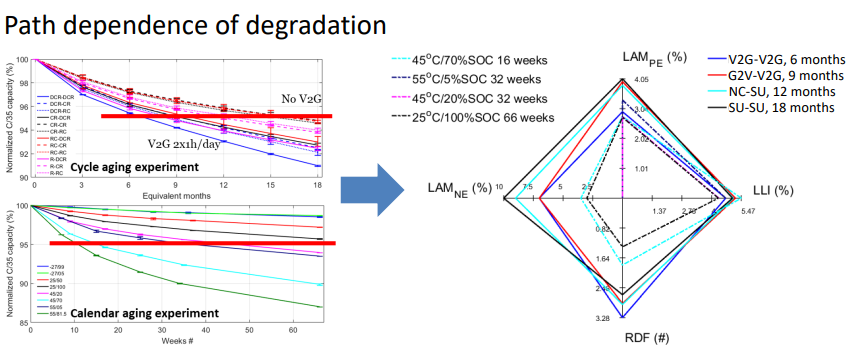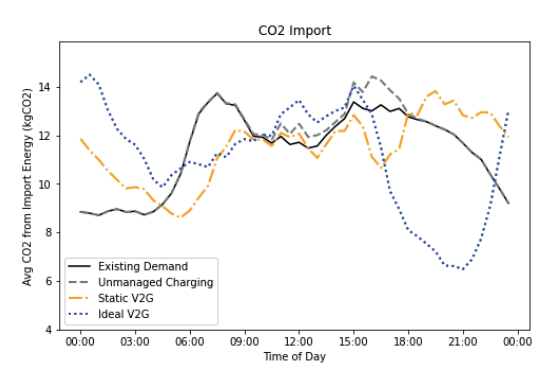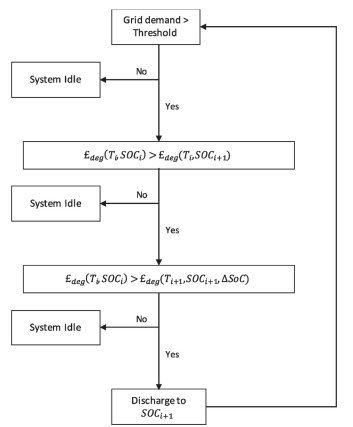California’s latest debate on mandating bi-directional charging capability in EVs brings with it the long-discussed predicament of its impact on EV batteries. In the last two decades, various theories and pilot projects have dwelled deep into this matter. Most agreed that strategic implementation of V2G technologies would yield fruitful results for EV owners, makers, and the grid. While the wide assumption degrades the reliability and durability of batteries, several ideas and theories propose to neutralize these adverse effects and make the most of the energy stored in EV batteries that may otherwise go to waste. But how viable is that idea, and will it finally lead to the proposed results? Let’s take a closer look to understand it better.
What Are V2G Technologies?
V2G or Vehicle-To-Grid technologies mediate the reciprocal power flow from EVs to another recipient. The list of recipients may include a grid, a microgrid, or an entity as small as a building. Successful application of these systems can mitigate the most significant challenges about renewable energy resources – intermittency and demand-supply unpredictability. As a power prospect, V2G is an imminent part of the highly recommended virtual power plants that aggregate distributed energy resources to stabilize electricity demand and supply to and from the power grid. When applied, V2G systems will play a key role in enhancing renewable energy adoption, grid stability, and optimization of grid upgrade costs. Therefore, it is necessary to investigate the chances of its successful implementation along with plausible solutions that may help overcome its biggest roadblocks.
Studies And Theories Favoring V2G Implementation
- Warwick University: Warwick University researched the feasibility of V2G technology in 2017. The team developed a comprehensive battery degradation model for a commercial lithium-ion battery. The legitimacy of this model was tested against six operationally different real-world usage cycles. It demonstrated a 4.6% transient error in capacity loss estimates and a 5.1% error in increased resistance over one year of cycling. It concluded that optimal charging balancing for driving purposes (∆SoCDrive) and V2G purposes (∆SoCV2G) could extend the battery’s lifetime and not let it waste due to calendar aging. The results of this study opened gates for further research to evaluate the possibility of improving a battery’s SoH (State of Health) by modifying its operational conditions via a smart grid and then subjecting it to V2G operations. To surmise, the study showed the possibility of reversing the widely assumed “battery degradation’ in a step-by-step approach that can be quantified and realized in the near future.

- Hawaii University: Hawaii University also conducted a study to understand the impact of bidirectional charging on EV batteries to help owners realize maximum profits. They showed that additional battery usage, even at constant power, proved detrimental to battery performance. In conclusion, it was agreed that intelligent or strategic implementation of V2G/G2V operations is a better and safer option. This is in contrast to blind V2G operations.

Other Studies and Theories
- EV-elocity Project: It was a government-funded pilot project deployed to gain commercial and customer insights on V2G technology. The results of this research corroborate the theory presented by Warwick University. According to the theory, careful charging and discharging of EV batteries can reduce their degradation by one-eighth. Commercially, it means that every user can save as much as £400 annually per vehicle. The project demonstrated the ability to balance a battery’s calendar and cycling aging to optimize its state of health (SoH). This optimization resulted in an improvement of 8.6-12.3% per year. Under this project, the UK government deployed V2G chargers across multiple locations. They concluded that it is possible to gain carbon, costs, and conditioning benefits through the intelligent implementation of V2G technology. This applies specifically to fleet vehicles.

- Nissan’s Global Projects On Bi-directional Charging: Nissan has led the way in global bidirectional charging. In the last few years, it has helped trials in North America, Japan, Europe, Australia, and Africa. In Australia, for instance, Nissan participated in a government-backed trial to demonstrate the benefits of V2G charging technology. A Nissan LEAF owner acquired the headline of this effort by using the car to offset the night-time energy usage at his solar-powered enterprise. Similarly, Nissan’s i-rEzEPT project aided EV integration into Germany’s power grid for 13-solar-enabled homes. The company registered compelling results in the first interim review. Several such projects have been piloted in Japan, Portugal, Thailand, the UK, and the US to showcase the positive effects of V2G applications that weigh much more against the degradation of battery life.
The Roadblocks
Despite unanimous support for the intelligent implementation of bi-directional charging, several questions challenge its deployment in real-time. Here are the biggest roadblocks:
Some Big Issues
- Too Many Assumptions: Warwick’s study, which supported the strategic implementation of bi-directional charging, made several assumptions that are yet to be proven in the real world. It assumed that the integrated smart grid could manipulate the EV’s operational conditions. This implies that the Battery Management System (BMS) used in the process will inform the grid about the vehicle’s energy requirement for upcoming trips. It will also inform the grid about the availability of extra energy that can be sent back to the grid. Then, it was assumed that V2I (Vehicle-to-Infrastructure) and vice versa were possible. These assumptions are yet to sync with the present status quo of V2G operations worldwide. Successfully incorporating machine learning algorithms and high computing power requires the intelligent capabilities of the BMS, which in turn mandates the development of standards addressing technical issues, cybersecurity, hybrid communications, and legal matters. All these developments are still a work in progress and may need a few more years to come into the picture.
- Prognostic Battery Aging Models Needed For Each EV Battery: Most studies were conducted on commercial Lithium-ion batteries under specific conditions. To advance the universal implementation of V2G technology, stakeholders need to develop similar prognostic battery models. These models should cover every kind of EV battery, including potential alternatives to lithium-ion batteries. Aging mechanisms differ according to the manufacturing process, cell design, elemental properties, and proprietary and chemical attributes of battery constituents. Car manufacturers need to delve deeper into creating more accurate online predictive models that can be executed in real-time. Additionally, they will need to develop microcontrollers to modify the capabilities of present-day BMS.

Additional Issues
- Due Consideration Needs To Be Given To Dynamic Charging and Discharging: The models used for testing the aging effect of charging and discharging cycles only considered typical aging stress factors. These factors include temperature, state of charge variations, capacity throughput, and charging and discharging current. They skipped other influential factors like constant power versus pulse power, rapid charging process, etc.
- Communication Protocols: Bi-directional charging involves a high level of communication between the grid and vehicles. All car manufacturers and systems must develop standardized protocols. As easy as it sounds, it has proved to be a big challenge. In Europe, for instance, there are no standard communication protocols for V2G operations, compromising systems’ compatibility.
- Proper Optimization of SoC and Degradation Relationship: SoC has an inverse relationship with the battery degradation rate. However, most studies in this respect tested batteries at normal and lower temperatures. Neutralizing battery degradation at higher temperatures is still a significant challenge. This challenge may impede the widespread adoption of V2G applications in Asian and African countries.
Final Words
Acknowledging the challenges mentioned above paves the path for further investigation and the successful neutralization of those challenges. Solving the complex equation between ambient temperature, SoC, and degradation determines the progress. Similarly, most research has yet been conducted in the context of the fleet. We need to establish further evidence for other modes of transport. But one thing is certain: the momentum in this direction will increase as the demand for EVs rises. Industry stakeholders will systematically address and resolve the challenges and dilemmas associated with V2G, V2I, V2H, and all V2X in due course.